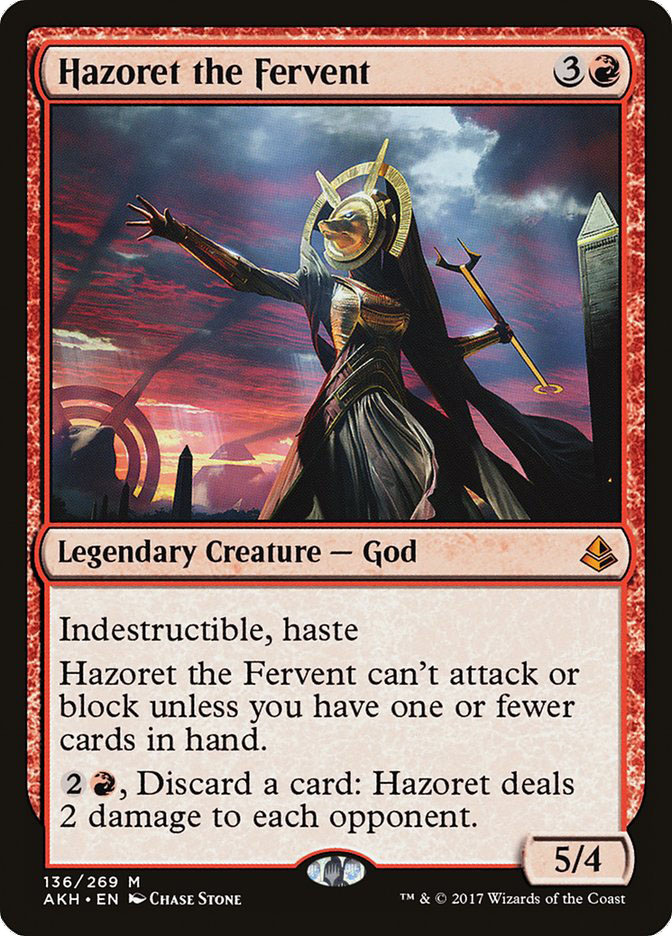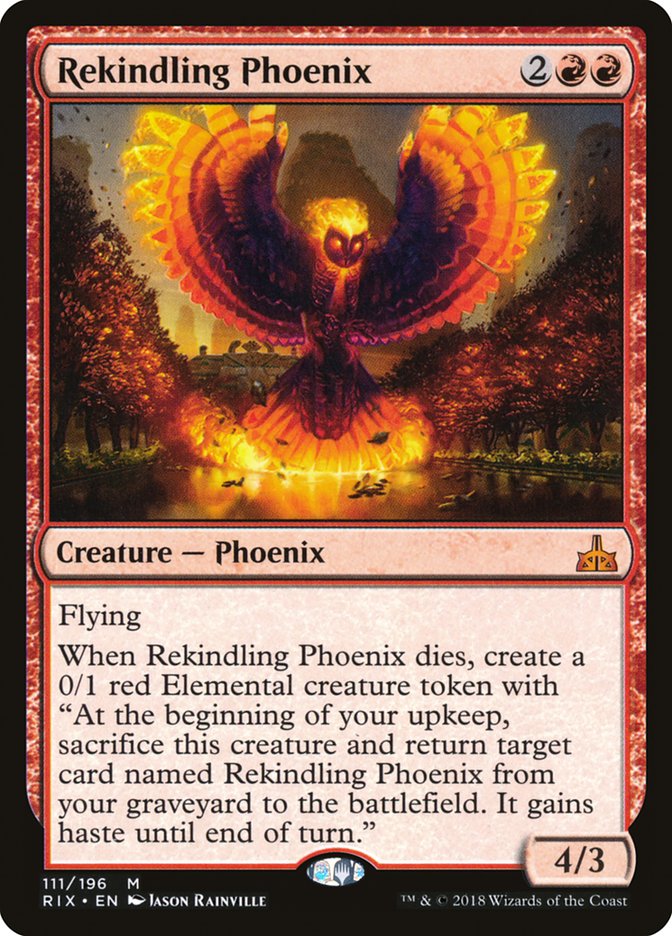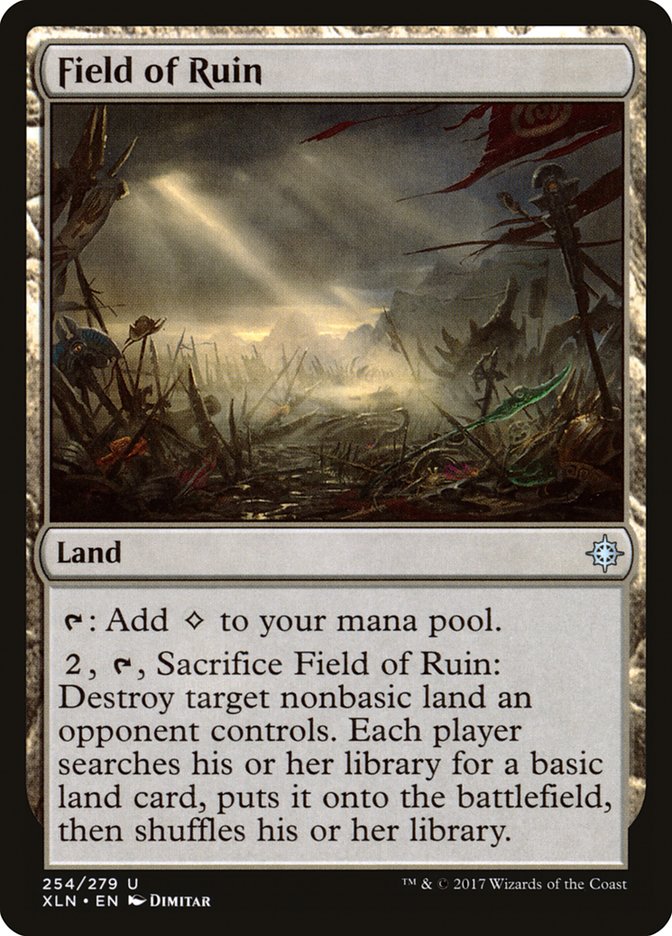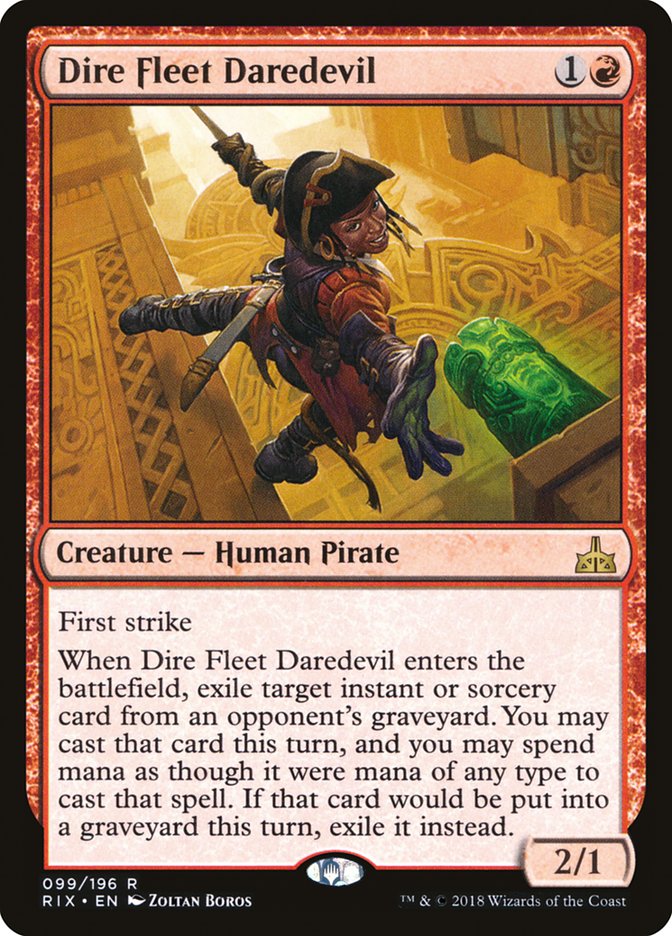While I was able to enjoy a nice relaxing weekend at home, skipping any Magic or traveling this past weekend, my eyes were glued to the coverage of GP Memphis. I was pleasantly surprised with the diversity of decks doing well, from stock decks like Mono-Red Aggro, U/B Control, and Grixis Energy to more fringe strategies like Abzan Approach, U/R Improvise, and even Five-Color Ramp (aka “the Ali Aintrazi special”). It was wonderful to see many great minds in the game bring such a variety of archetypes to the event.
So what has Standard really been looking like from the viewer’s standpoint? Let’s get into some of the highlights I took note of while observing this past weekend.
1. Hazoret the Fervent vs. The Scarab God
This seems like a fitting headline for what defines this Standard format. The two powerful Gods have an immediate impact on the game, essentially demanding an answer on sight. They also are not answered by typical removal, which results in people having to accommodate with answers in their maindeck. Vraska’s Contempt is the type of card you’d only have room for one or two of in a typical Standard format, but because of the looming presence of these two cards, we see it almost exclusively as a four-of in black midrange and control decks.
Also, I’ve noticed that the “Vraska’s Contempt turn” in a game of Standard is one of the most important decision points you’ll face. Knowing when to deploy your big threat when facing untapped mana can make or break a game of Standard. In fact, just a few rounds ago, I watched Brad Nelson playing against Grixis Energy, where his opponent did not play appropriately around an obvious Vraska’s Contempt. On his Turn 5, when Brad had just played his fourth untapped land and said go, his opponent jammed a copy of The Scarab God, only to see it get exiled and then not have a follow-up powerhouse play.
Here, it likely would have been better for him to have just passed the turn back to Brad. Why would he let all the mana go to waste, you might ask? Because it also denies Brad the opportunity for him to use his mana! It’s simply bad tempo to get your best threat answered there when you could potentially force the opponent to use that mana on a more inconvenient turn. Let’s say you pass on Turn 5 and Brad decides to follow up with a threat of his own. That means you get to answer Brad’s play and then follow up with your own, forcing Brad to use Vraska’s Contempt on Turn 6 when the mana wasn’t readily available.
2. Everyone has a plan for Mono-Red, but you still just lose to it sometimes.
If there has been one thing to take away so far from observing Standard results, it’s that Mono-Red is still a force to be reckoned with. While the most recent Standard bannings hurt, the deck’s core is still intact and it also got some upgrades from Rivals of Ixalan with Rekindling Phoenix and Fanatical Firebrand.
The story of the red deck hasn’t changed, though. Sometimes they will just run you over by casting three spells by Turn 2 or 3 when the other player has only cast one. But then there are also the games where the non-red player is overloaded on things like spot removal or one-for-ones and Hazoret the Fervent and Chandra, Torch of Defiance run rampant. Mono-Red is just the perfect combination of fast, resilient, and capable of playing at all stages of the game. As long as Hazoret the Fervent is still around in the format, I’d expect Mono-Red to be a Tier 1 strategy.
3. Field of Ruin is great and likely underplayed.
I could write a whole article on the impact Field of Ruin has had on Constructed. It was subtle at first, but at this point people who play a lot of Modern know this card is a powerhouse. It has even started showing up in Legacy a bit, a format where Wasteland is available.
In Eternal formats, the card has a purpose for destroying problematic lands and messing up flimsy manabases. Now, in Standard, you aren’t typically going to be able to “mana screw” your opponent. But it does have some other critical functions that play a role in making it a real card in the format.
First and foremost is the fact that it destroys cards that transform into lands. Search for Azcanta, Arguel’s Blood Fast, Legion’s Landing, and Path of Mettle all see a reasonable amount of play in Standard. When these cards transform into lands, they typically provide an insurmountable amount of advantage that can’t be answered by a spell of your own. For example, an unchecked Azcanta, the Sunken Ruin in any midrange or control mirror is essentially game over. Even just one activation feels like the checkpoint if the game is even. Being able to destroy these lands on sight is crucial and Field of Ruin is the only real card that does so.
Second is the fact that it turns on revolt for Fatal Push. The decks I’ve seen that have access to Field of Ruin in Standard have mostly been U/B decks. That means two things – they both play Fatal Push and typically don’t have the ability to revolt it. But thanks to Field of Ruin being part of your manabase, it means you can confidently have revolt for your Fatal Pushes without having to trigger it via one of your few creatures being killed. Upgrading Fatal Push to killing three- and four-drops is a huge deal in a format where typically it might be dead later in a game. It also means that since you’re going to be able to trade your Fatal Pushes more effectively, you get you to save your crucial copies of Vraska’s Contempt more often.
Last, the big and obvious highlight of Field of Ruin is that it fixes your colored mana. It makes it a lot more justifiable to keep a two-lander with a Field of Ruin, since hitting any third land means you can likely have all your colors. It allows a deck like U/B Control, which plays both UU and BB spells to fix their colors on a turn they might not have otherwise used their mana.
After Memphis
So you’ve heard some of my key insights about the format, but what decks will come out on top after this weekend?
To the surprise of no one, Grixis Energy had a stellar performance at GP Memphis, putting three players into the Top 8. In fact, as I’m writing this, I just watched the Grixis Energy mirror in the quarterfinals between Andrew Tenjum and Matt Kling. The deck is without a doubt the talk of the tournament.
Creatures (15)
- 1 Gonti, Lord of Luxury
- 1 Torrential Gearhulk
- 4 Whirler Virtuoso
- 4 Glint-Sleeve Siphoner
- 3 The Scarab God
- 2 Dire Fleet Daredevil
Planeswalkers (2)
Lands (26)
Spells (17)

This is Matt Kling’s list from GP Memphis. I wanted to highlight his list because of the interesting innovation of Dire Fleet Daredevil, a card I think will see a lot more play across several formats. I’ve even seen it pop up in Grixis Death’s Shadow and other midrange lists online in Modern, but also in Five-Color Humans as well.
When your opponent has spells in their deck, Dire Fleet Daredevil is a sorcery-speed Snapcaster Mage with a better body. As a player who is all about casting as many Snapcaster Mages as I can, I absolutely love the inclusion of Dire Fleet Daredevil in Grixis Energy for two main reasons.
First, the deck lacks early plays. Without a Glint-Sleeve Siphoner, you have no proactive plays on Turn 2, so having something else on the early turns of the game is important until you get your shop set up.
Second, basically every deck has spells to take advantage of. This means it’ll often be a two-for-one as early as Turn 3 or 4 which has a huge impact on a game of Standard. Double spelling – off one card, mind you – on that early of a turn is incredibly powerful and something most decks won’t have the opportunity to do.
Moving past the Daredevil, I love the fact that Kling decided to bring Confiscation Coup back. Obviously it’s not the card it was before, but it’s still the best five-drop you can cast to trump someone else’s. Additionally, most of the threats you’ll be aiming to take with it are going to be four or five mana, which means you only need to have one energy in the bank to complete your goal of taking their best creature.
I do think Grixis Energy has the tools to beat everything, which makes it appealing as an option. It has good game versus Mono-Red, likely its big key to success. On top of that, the sideboard really fixes up some of the more troublesome matchups like U/B Control and U/W Approach.
Speaking of U/B Control, it also had a terrific weekend. Hall of Famer and stone-cold master Eric Froehlich took the deck to a Top 8 finish in Memphis:
Creatures (6)
Lands (26)
Spells (28)

I absolutely love this deck! I even took it for a spin in the most recent PPTQ I played a few weekends ago, when Jim Davis and Todd Stevens helped put this deck at the forefront of the Standard metagame. U/B Control is very strong against most of the decks in the format and absolutely demolishes U/B Midrange and Grixis Energy. Its only real weakness in my experience is against Mono-Red, which, admittedly, is tough but certainly winnable. If you can steal some wins against them, I think a strong U/B Control pilot will be well set up to have a good tournament.
Also, I’d like to note that the Smash Brothers, Brad Nelson and Corey Baumeister, chose to bring U/B Midrange to GP Memphis. And while they both managed to have deep runs in the tournament – no surprise there – neither managed to reach the elimination rounds. This leads me to believe that U/B Control was the Dimir deck of choice for the weekend.
The last deck I can’t leave without talking about is Sultai Constrictor.
Creatures (26)
- 2 Verdurous Gearhulk
- 4 Bristling Hydra
- 4 Servant of the Conduit
- 4 Winding Constrictor
- 4 Glint-Sleeve Siphoner
- 4 Walking Ballista
- 4 Jadelight Ranger
Lands (24)
Spells (10)
Sideboard

Aaron Barich never fails to bring the spice to a given tournament and it looks like he’s been reading what Jadine Klomparens has to say on this archetype. Barich always tries to play low-to-the-ground creature decks with a small assortment of counter or protection spells. We’ve seen G/B Constrictor variants be part of the format for quite some time, but almost never have they been Tier 1 or the deck to beat.
Aaron decided that for GP Memphis that he didn’t want to play The Scarab God nor he didn’t want to answer it with clunky removal spells. He wanted to go under it, which I think might have been the best way to go about doing things. Hadama’s Climb is the card that he praised all weekend and it looked insane on camera when it did show up. The fact that it’s the only blue card in his maindeck should speak volumes as well.
Standard has looked wonderful from the sidelines. There have been a variety of archetypes doing well and no shortage of competitive decks to choose from. Eric Froehlich even mentioned that the format was comparable to Modern, insofar as you could play any type of deck you want and they we’re all viable. Standard looks better than it has in a long time, and I’m really looking forward to diving in and playing more of it. Until then, I’ll be touching up my Legacy chops for SCG Worcester this weekend. I’m on the hunt to catch my new SCG Tour rival Benjamin Nikolich in points for the seasonal race.
Wish me luck!







